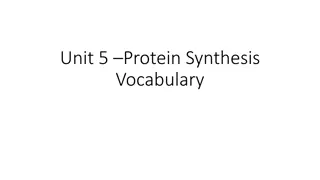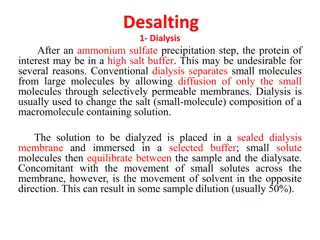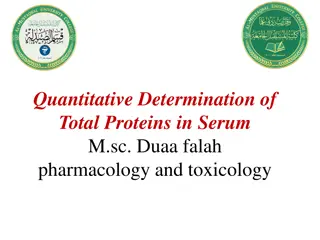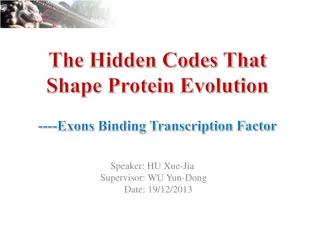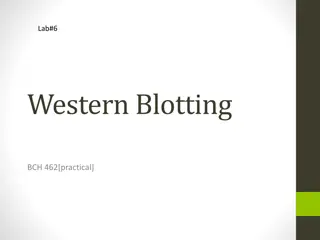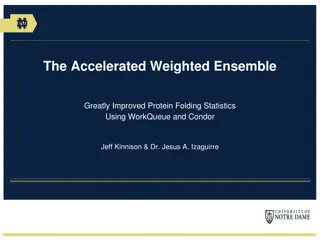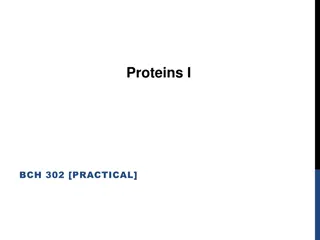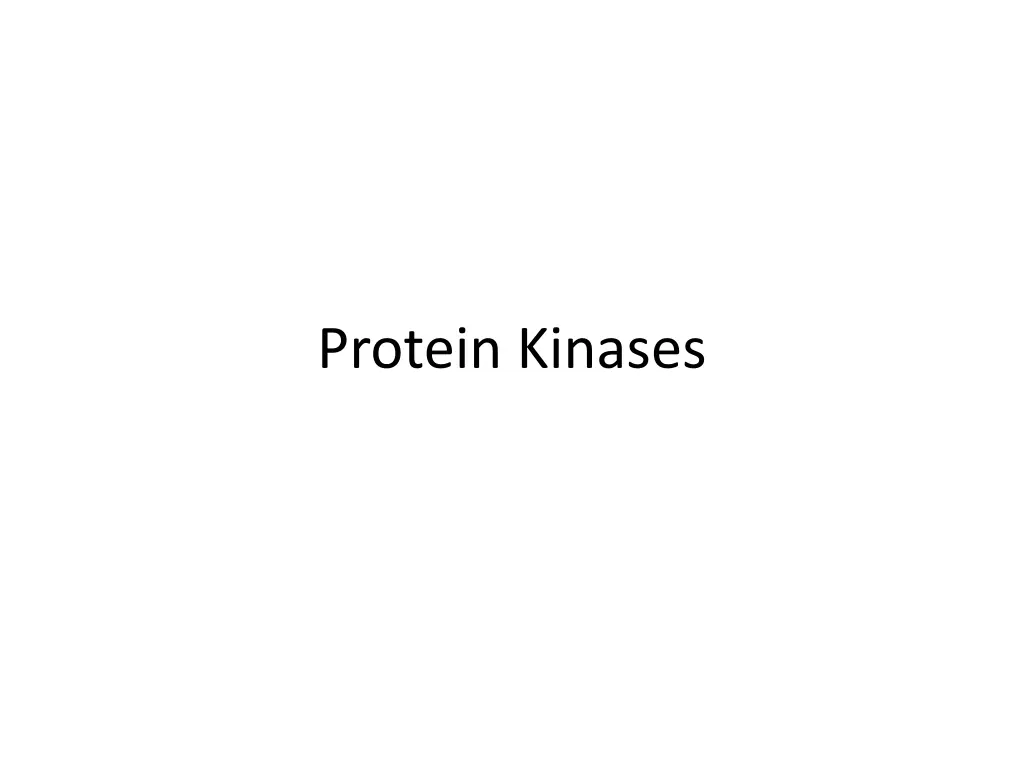
Protein Kinases: Functions, Classification, and Importance
Discover the world of protein kinases, enzymes that play a crucial role in cellular signaling and pathways. Learn about their classification, historical significance, and the vast number of genes encoding them in humans. Explore the diverse functions and types of protein kinases found in animal cells, as well as their essential role in regulating various cellular processes like cell division and apoptosis.
Download Presentation

Please find below an Image/Link to download the presentation.
The content on the website is provided AS IS for your information and personal use only. It may not be sold, licensed, or shared on other websites without obtaining consent from the author. If you encounter any issues during the download, it is possible that the publisher has removed the file from their server.
You are allowed to download the files provided on this website for personal or commercial use, subject to the condition that they are used lawfully. All files are the property of their respective owners.
The content on the website is provided AS IS for your information and personal use only. It may not be sold, licensed, or shared on other websites without obtaining consent from the author.
E N D
Presentation Transcript
Protein kinase A protein kinase is a kinase enzyme that modifies other proteins by chemically adding phosphate groups to them (phosphorylation). Phosphorylation usually results in a functional change of the target protein by changing enzyme activity, cellular location, or association with other proteins. The human genome contains about 518 protein kinase genes and they constitute about 2% of all human genes. Kinases are known to regulate the majority of cellular pathways, especially those involved in signal transduction. Protein kinases are also found in bacteria and plants, where they take an active participation in mechanistic cellular signaling.
Protein Kinases in Animal Cells Kinase s Cell division Apoptosis The first messenger interacts with a receptor and a second messenger is formed
History and Importance About 518 genes in humans encode protein kinases; Protein kinases are the fourth largest gene family in humans C2H2 zinc finger proteins (3%) G-protein coupled receptors (2.8%) Major histocompatibility (MHC) complex protein family (2.8%)
How Many Protein Kinases Are There? The kinome refers to all protein kinases in the genome There are 478 conventional eukaryotic protein kinases (ePKs) plus 106 pseudogenes 388 Protein-serine/threonine kinases 90 Protein-tyrosine kinases 58 receptor PTKs 32 Non-receptor PTKs There are 40 atypical protein kinases (e.g. EF2K/alpha kinases) 478 + 40 = 518
Protein Kinase Classifications Protein-Serine/threonine Protein-Tyrosine Receptor: ligand binding domain and catalytic site on the same polypeptide Non-receptor: catalytic domain separate from the receptor Dual Specificity (both serine/threonine and tyrosine) also occur Broad Specificity: have several substrates, e.g., PKA Narrow Specificity: have one or a few substrates, e.g., pyruvate dehydrogenase kinase with one substrate Classified by activator: PKA, PKG, PKC
General Classes I ACG Group Protein kinase A; cyclic AMP-dependent protein kinase Protein kinase C Protein kinase G Basic amino acid-directed enzymes that phosphorylate serine/threonine.
General Classes II CaMK Calcium-calmodulin-dependent protein kinases I II III IV Type II is a broad specificity kinase The others are dedicated kinases with a limited substrate specificity
General Classes III CMGC Cyclin-dependent protein kinases These are important regulators of the cell cycle MAP (Mitogen activated protein/microtubule associated protein) kinases Many of these promote cell division GSK3 (glycogen synthase kinase-3) Clk (Cyclin-dependent like kinase)
General Classes IV PTK (Protein-tyrosine kinases) Receptor, e.g., epidermal growth factor receptor, insulin receptor Non-receptor, e.g., Src, Abl protein kinases Specifically phosphorylate protein-tyrosine (note they are not tyrosine kinases but protein-tyrosine kinases)
Reactions and Types of Protein Kinases Be able to recognize the three amino acids with an OH in their R-group Serine Threonine Tyrosine
Activation of Protein Kinases Known PKA activation mechanism It is the only one where there is a dissociation of regulatory catalytic subunits This was the first activation mechanism to be described, but it turns out to be atypical or unique PKG, allosteric PKC, allosteric subunits from
Protein Kinase A Activated by cAMP Regulation of glycogen, sugar and Lipid metabolism. Secondary Messenger The protein enzyme contains two catalytic subunits and two regulatory subunits. When there is no cAMP, the complex is inactive. When cAMP binds to the regulatory subunits, their conformation is altered, causing the dissociation of the regulatory subunits, which activates protein kinase A and allows further biological effects.
Protein Kinase A Structure Bilobed N-lobe (upper) mostly beta sheet C-lobe (lower) mostly alpha helix Active site between the two lobes ATP is bound in the active site
PKA Substrate Specificity Basic-Basic-Xxx-Ser-Hydrophobic is preferred
Earl W. Sutherland, Jr (cAMP) Edwin Krebs (PKA) Albert G. Gilman (G-protein) Edmund Fischer (PKA) Martin Rodbell( G-protein)
Protein Kinase G Activated by cGMP Second second messenger protein kinase (after cAMP) Little known about physiological protein substrates despite needs extensive investigation Two types of guanylyl cyclase Second messenger generated by atrial naturetic factor as an integral membrane guanylyl cyclase. Second messenger generated by NO action on the soluble guanylyl cyclase reaction.
Action of cGMP Review Fig 19-23 for NO biosynthesis
Calcium-Dependent Protein Kinases Protein Kinase C Requires calcium, diacylglycerol, and phospholipid for activity Diacylglycerol is generated by the action of phospholipase C, C refers to calcium DAG and phospholipid were also described as necessary for the activation of this enzyme It is paradoxical to have PKCs that are independent of Ca2+ and DAG Calcium-Calmodulin-Dependent Protein Kinases CAM Kinases I, II, III, IV Several other protein kinases activated by calmodulin including myosin-light chain kinase, phosphorylase kinase, some isoforms of adenylyl cyclase and some isoforms of phosphodiesterase
Protein Kinase C Family PKC C refers to calcium DAG and phospholipid were also described as necessary for the activation of this enzyme There are many isozymes that are products of different genes
Tyrosine kinase mechanism Tyrosine kinase receptors are a family of receptors with a similar structure. They each have a tyrosine kinase domain (which phosphorylates proteins on tyrosine residues), a hormone binding domain, and a carboxyl terminal segment with multiple tyrosines for autophosphorylation. When hormone binds to the extracellular domain the receptors aggregate.
Biochemical mechanism of action of tyrosine kinase
Classification of RTK Receptor tyrosine kinases (RTKs)-The RTK family includes the receptors for insulin and for many growth factors such as Epidermal growth factor (EGF) Fibroblast growth factor(FGF) Platelet-derived growth factor (PDGF) Vascular endothelial growth factor(VEGF) Nerve growth factor (NGF) Nonreceptor tyrosine kinases (NRTKs) Src Proto oncogene Janus kinases (Jaks) Abl Abelson murine leukemia
Application The Role of Tyrosine Kinase Activity in Endocytosis, Compartmentation, and down regulation of the Epidermal Growth Factor Receptor
Ribosomal s6 kinase Ribosomal s6 kinase (rsk) is a family of protein kinases involved in signal transduction. There are two subfamilies of rsk, p90rsk, also known as MAPK-activated protein kinase-1 (MAPKAP-K1), and p70rsk, also known as S6-H1 Kinase or simply S6 Kinase. There are three variants of p90rskin humans, rsk 1-3. Rsks are serine/threonine kinases and are activated by the MAPK/ERK pathway. There are two known mammalian homologues of S6 Kinase: S6K1 and S6K2.
Cross talk b/w signaling pathways Crosstalk refers to instances in which one or more components of one signal transduction pathway affects another. Most common form being crosstalk between proteins of signaling cascades. In these signal transduction pathways, there are often shared components that can interact with either pathway. A more complex instance of crosstalk can be observed with transmembrane crosstalk between the extracellular matrix (ECM) and the cytoskeleton.
cAMP pathway One example of crosstalk between proteins in a signalling pathway can be seen with cyclic adenosine monophosphate's (cAMP) role in regulating cell proliferation by interacting with the mitogen-activated protein (MAP) kinase pathway. cAMP is a compound synthesized in cells by adenylate cyclase in response to a variety of extracellular signals.. cAMP primarily acts as an intracellular second messenger whose major intracellular receptor is the cAMP-dependent protein kinase (PKA) that acts through the phosphorylation of target proteins. The signal transduction pathway begins with ligand-receptor interactions extracellularly. This signal is then transduced through the membrane, stimulating adenylyl cyclase on the inner membrane surface to catalyze the conversion of ATP to cAMP.
ERK, (Extra cellular signal regulated kinases) a participating protein in the MAPK signaling pathway, can be activated or inhibited by cAMP. cAMP can inhibit ERKs in a variety of ways, most of which involve the cAMP- dependent protein kinase (PKA) and the inhibition of Ras-dependent signals to Raf- 1. cAMP can also stimulate cell proliferation by stimulating ERKs. This occurs through the induction of specific genes via phosphorylation of the transcription factor CREB by PKA. Though ERKs do not appear to be a requirement for this phosphorylation of CREB, the MAPK pathway.
ECM Crosstalk can even be observed across membranes. Membrane interactions with the extracellular matrix (ECM) and with neighboring cells can trigger a variety of responses within the cell. However, the topography and mechanical properties of the ECM also come to play an important role in powerful, complex crosstalk with the cells growing on or inside the matrix.
For example, integrin-mediated cytoskeleton assembly and even cell motility are affected by the physical state of the ECM. Binding of the 5 1 integrin to its ligand (fibronectin) activates the formation of fibrillar adhesions and actin filaments. In turn, binding of the same integrin ( 5 1) to an immobilized fibronectin ligand is seen to form highly phosphorylated focal contacts/focal adhesion (cells involved in matrix adhesion) within the membrane and reduces cell migration rates and matrix immobilization. Matrix immobilization inhibits the formation of fibrillar adhesions and matrix reorganization. Likewise, players of other signaling pathways inside the cell can affect the structure of the cytoskeleton and thereby the cell s interaction with the ECM.










